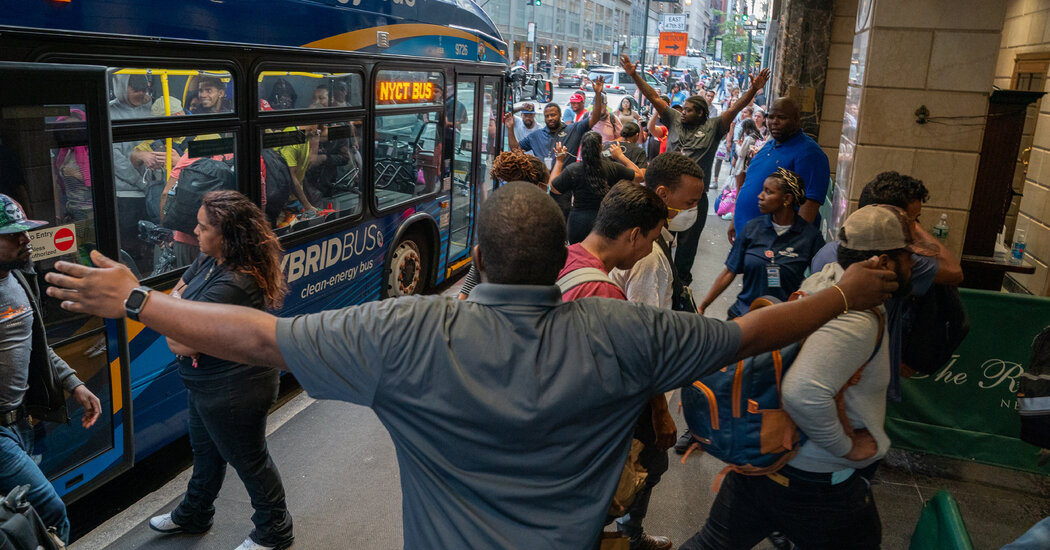How to Catch Pandemic Fraud? Prosecutors Try Novel Methods.
Federal prosecutors are scrambling to recoup billions of dollars in pandemic aid from people who falsely obtained funds from government programs that were intended to keep the economy afloat during the Covid shutdowns.
In some districts, prosecutors are screening those suspected of a violent crime for potential involvement in pandemic fraud schemes. Other investigators are putting together “strike force teams” to unravel the most sophisticated enterprises or leaning on local officials to steer them toward potential fraudsters in their areas.
The moves come as the federal government looks for novel ways to root out what officials say was an enormous number of fraudulent claims that were submitted and approved during the pandemic. Many of the programs that were set up to dole out relief money required minimal proof from those seeking funds and approved applications quickly in order to pump money into the economy.
While the exact amount that was stolen is unknown, the Small Business Administration’s inspector general estimated that more than $200 billion — or at least 17 percent of the roughly $1.2 trillion in pandemic loans the agency doled out — was disbursed to “potentially fraudulent actors.” Nearly $30 billion has been seized or returned to the agency, according to the office.
Thousands of investigations are still underway. The Labor Department’s inspector general has about 160,000 open investigations focused on unemployment-insurance fraud from the pandemic.
But rooting out those who defrauded pandemic-relief programs has proved difficult, given the sheer amount of fraud. So far, the federal government has charged more than 2,230 defendants with schemes and offenses related to pandemic fraud, according to the Justice Department. More than 550 convictions have been made related to fraud involving funds from the Paycheck Protection Program and the Economic Injury Disaster Loan program, according to the S.B.A.’s office of inspector general.
Michael Galdo, the acting director of Covid-19 fraud enforcement at the Justice Department, said there was a “wide variety of different approaches across U.S. attorney’s offices,” which have a large amount of freedom to determine the most effective way to catch fraudsters.
Power in Local Connections
In the Northern District of Mississippi, officials at the U.S. attorney’s office are traveling to individual counties and asking local officials to review lists of people who received pandemic loans. That approach can help prosecutors catch recipients they might not otherwise find, since local officials typically know, for example, whether someone owned a business, overstated the number of employees on an application or listed an address that was actually an empty lot.
Clay Joyner, the U.S. attorney for the district, said the approach had helped uncover more cases than the district had the resources to criminally prosecute, so the office is pursuing civil cases in many investigations that involve smaller loans.
“Thousands of the loans are for those lower-tier amounts,” Mr. Joyner said. “If you were trying to pursue all of these cases criminally, it would almost be impossible.”
The office’s civil division has reached over 200 judgments, more than any other district in the country. Officials have recovered over $2.2 million so far, although they expect to recover more than $23 million through their civil judgments so far.
Mr. Joyner said the office had also pursued civil cases because the financial consequences could be severe. Under a federal law commonly used for civil fraud cases, individuals could be required to pay three times the amount of a stolen loan, in addition to penalties and fees. Although the money usually has been spent already, most fraudsters agree to return the full amount through a repayment plan, Mr. Joyner said.
Officials said they did not initially plan to pursue more civil cases, but they realized they could take advantage of the district’s small-town, rural nature after an attorney in the office recognized the names of loan recipients and suspected that many did not own businesses because he had grown up in the same area.
Scrutiny of Other Suspects
Officials at the U.S. attorney’s office in Maryland have started screening all new suspects of violent crime and illegal possession of firearms for pandemic fraud. Erek L. Barron, the U.S. attorney for the district, said the method had allowed officials to pursue investigations they normally would not have the capacity to take on.
“We can’t take each and every case, so we have to be very thoughtful about the dollar amounts and the individuals that we investigate and prosecute,” he said.
Since officials instituted the process in 2021, more than 60 percent of screened cases have turned up reasonable suspicion of pandemic-related fraud, Mr. Barron said, adding that the overlap had “presented an opportunity to go after two priorities in one.”
“Those who are involved in violence, it’s not a stretch to imagine that they’re also willing participants in other wrongdoing,” he said.
One recent case involved Jerry Phillips of Capitol Heights, Md., who was sentenced to seven years in federal prison after admitting to obtaining more than $1 million in relief funds using fake and stolen identities. After he was arrested and officials searched his residence, they recovered four “ghost guns,” including one he had illegally modified into a machine gun. Mr. Phillips had purchased the guns online, in part with an alias and address he used for fraud schemes, according to court documents.
Special Teams for Fraud
The Justice Department has also established “strike force teams” in several U.S. attorney’s offices. Phillip A. Talbert, the U.S. attorney for the Eastern District of California, said its joint strike force with the Central District of California used a data-driven approach to identify large fraud schemes. Analysts from the F.B.I. and at least five other federal agencies work with the offices, searching databases for patterns of suspicious activity.
“If you just looked at one application or a couple applications, it may not be apparent that’s just a little piece of the fraud scheme,” Mr. Talbert said.
The office’s earlier fraud cases originated mostly from referrals by banks and state and federal agencies. One case involved Andrea M. Gervais of Roseville, Calif., who was sentenced to 36 months of probation after pleading guilty to theft of government money in a scheme involving more than 90 fraudulent unemployment claims. The case began after investigators discovered someone had filed a claim using the identity of a sitting U.S. senator, which was processed for payment. The official was Senator Dianne Feinstein of California, according to a person familiar with the investigation. Senator Feinstein’s office confirmed that a person had used the senator’s name to file fraudulent unemployment claims, but it declined to provide additional comment.
Mr. Talbert said the strike force would help the office investigate cases that are harder to detect, such as those involving international fraud rings.
Dan Fruchter, an assistant U.S. attorney in the Eastern District of Washington, said officials initially focused on cases that were less complicated to prove, such as those involving fake businesses, but he also expected the office to prosecute more complex cases in the coming years. Investigations can take longer if people with legitimate businesses overstated facts in their applications or made improper purchases, for instance.
Since forming its own strike force last year to strengthen coordination with federal law enforcement, the office has charged 19 defendants and recovered about $4 million.
A Broad Sweep
In addition to U.S. attorney’s offices, hundreds of people across more than 40 offices of inspectors general are working on pandemic fraud investigations, as are agents from the F.B.I., the Secret Service, the Postal Inspection Service, Homeland Security Investigations and Internal Revenue Service Criminal Investigation.
Brian Miller, the country’s special inspector general for pandemic recovery, said he expected to uncover new leads over the next few years as more borrowers defaulted on pandemic loans, a “red flag” for potential fraud. He said default rates on interest payments for some programs had already been alarmingly high, and he urged Congress to fund the office past 2025, when many final payments are due.
Michael Horowitz, the Justice Department’s inspector general and chairman of the Pandemic Response Accountability Committee, which is composed of 20 agency inspectors general, said investigators had prioritized mostly multimillion-dollar fraud cases, but he anticipated prosecutors would pursue more lower-dollar cases in the coming years.
“They’re still big numbers,” Mr. Horowitz said. “In any other time, they would be viewed as bigger frauds.”


